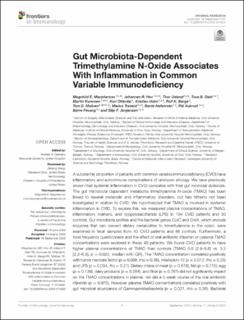| dc.contributor.author | Macpherson, Magnhild Eide | |
| dc.contributor.author | Hov, Johannes Espolin Roksund | |
| dc.contributor.author | Ueland, Thor | |
| dc.contributor.author | Dahl, Tuva Børresdatter | |
| dc.contributor.author | Kummen, Martin | |
| dc.contributor.author | Otterdal, Kari | |
| dc.contributor.author | Holm, Kristian | |
| dc.contributor.author | Berge, Rolf Kristian | |
| dc.contributor.author | Mollnes, Tom Eirik | |
| dc.contributor.author | Trøseid, Marius | |
| dc.contributor.author | Halvorsen, Bente | |
| dc.contributor.author | Aukrust, Pål | |
| dc.contributor.author | Fevang, Børre | |
| dc.contributor.author | Jørgensen, Silje Fjellgård | |
| dc.date.accessioned | 2020-10-27T07:40:15Z | |
| dc.date.available | 2020-10-27T07:40:15Z | |
| dc.date.created | 2020-10-19T22:34:08Z | |
| dc.date.issued | 2020 | |
| dc.identifier.citation | Frontiers in Immunology. 2020, 57:574500 1-12. | en_US |
| dc.identifier.issn | 1664-3224 | |
| dc.identifier.uri | https://hdl.handle.net/11250/2685122 | |
| dc.description.abstract | A substantial proportion of patients with common variable immunodeficiency (CVID) have inflammatory and autoimmune complications of unknown etiology. We have previously shown that systemic inflammation in CVID correlates with their gut microbial dysbiosis. The gut microbiota dependent metabolite trimethylamine N-oxide (TMAO) has been linked to several metabolic and inflammatory disorders, but has hitherto not been investigated in relation to CVID. We hypothesized that TMAO is involved in systemic inflammation in CVID. To explore this, we measured plasma concentrations of TMAO, inflammatory markers, and lipopolysaccharide (LPS) in 104 CVID patients and 30 controls. Gut microbiota profiles and the bacterial genes CutC and CntA, which encode enzymes that can convert dietary metabolites to trimethylamine in the colon, were examined in fecal samples from 40 CVID patients and 86 controls. Furthermore, a food frequency questionnaire and the effect of oral antibiotic rifaximin on plasma TMAO concentrations were explored in these 40 patients. We found CVID patients to have higher plasma concentrations of TMAO than controls (TMAO 5.0 [2.9–8.6] vs. 3.2 [2.2–6.3], p = 0.022, median with IQR). The TMAO concentration correlated positively with tumor necrosis factor (p = 0.008, rho = 0.26), interleukin-12 (p = 0.012, rho = 0.25) and LPS (p = 0.034, rho = 0.21). Dietary intake of meat (p = 0.678), fish (p = 0.715), egg (p = 0.138), dairy products (p = 0.284), and fiber (p = 0.767) did not significantly impact on the TMAO concentrations in plasma, nor did a 2-week course of the oral antibiotic rifaximin (p = 0.975). However, plasma TMAO concentrations correlated positively with gut microbial abundance of Gammaproteobacteria (p = 0.021, rho = 0.36). Bacterial Macpherson et al. Microbiota, TMAO, Inflammation in CVID gene CntA was present in significantly more CVID samples (75%) than controls (53%), p = 0.020, potentially related to the increased abundance of Gammaproteobacteria in these samples. The current study demonstrates that elevated TMAO concentrations are associated with systemic inflammation and increased gut microbial abundance of Gammaproteobacteria in CVID patients, suggesting that TMAO could be a link between gut microbial dysbiosis and systemic inflammation. Gut microbiota composition could thus be a potential therapeutic target to reduce systemic inflammation in CVID. | en_US |
| dc.language.iso | eng | en_US |
| dc.publisher | Frontiers Media | en_US |
| dc.rights | Navngivelse 4.0 Internasjonal | * |
| dc.rights.uri | http://creativecommons.org/licenses/by/4.0/deed.no | * |
| dc.title | Gut microbiota-dependent trimethylamine N-oxide associates with inflammation in common variable immunodeficiency | en_US |
| dc.type | Peer reviewed | en_US |
| dc.type | Journal article | en_US |
| dc.description.version | publishedVersion | en_US |
| dc.source.pagenumber | 1-12 | en_US |
| dc.source.volume | 57:574500 | en_US |
| dc.source.journal | Frontiers in Immunology | en_US |
| dc.identifier.doi | 10.3389/fimmu.2020.574500 | |
| dc.identifier.cristin | 1840727 | |
| dc.description.localcode | © 2020 Macpherson, Hov, Ueland, Dahl, Kummen, Otterdal, Holm, Berge, Mollnes, Trøseid, Halvorsen, Aukrust, Fevang and Jørgensen. This is an open-access article distributed under the terms of the Creative Commons Attribution License (CC BY). The use, distribution or reproduction in other forums is permitted, provided the original author(s) and the copyright owner(s) are credited and that the original publication in this journal is cited, in accordance with accepted academic practice. No use, distribution or reproduction is permitted which does not comply with these terms. | en_US |
| cristin.ispublished | true | |
| cristin.fulltext | original | |
| cristin.qualitycode | 1 | |

